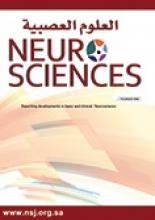Research ArticleOriginal Article
Open Access
Exogenous human urinary kallidinogenase increases cerebral blood flow in patients with acute ischemic stroke
Jing Miao, Fang Deng, Ying Zhang, Hong Y. Xie and Jia C. Feng
Neurosciences Journal April 2016, 21 (2) 126-130; DOI: https://doi.org/10.17712/nsj.2016.2.20150581
Jing Miao
From the Department of Neurology and Neuroscience Center, The First Affiliated Hospital of Jilin University, Changchun, Jilin, People’s Republic of China
PhDFang Deng
From the Department of Neurology and Neuroscience Center, The First Affiliated Hospital of Jilin University, Changchun, Jilin, People’s Republic of China
PhDYing Zhang
From the Department of Neurology and Neuroscience Center, The First Affiliated Hospital of Jilin University, Changchun, Jilin, People’s Republic of China
PhDHong Y. Xie
From the Department of Neurology and Neuroscience Center, The First Affiliated Hospital of Jilin University, Changchun, Jilin, People’s Republic of China
PhDJia C. Feng
From the Department of Neurology and Neuroscience Center, The First Affiliated Hospital of Jilin University, Changchun, Jilin, People’s Republic of China
Md, PhD
References
- ↵
- Duong TQ
- ↵
- Pan F,
- Hernandez L,
- Ward A
- ↵
- Ishiguro M,
- Kawasaki K,
- Suzuki Y,
- Ishizuka F,
- Mishiro K,
- Egashira Y,
- et al.
- ↵
- Bennink E,
- Horsch AD,
- Dankbaar JW,
- Velthuis BK,
- Viergever MA,
- de Jong HW
- ↵
- Han L,
- Li J,
- Chen Y,
- Zhang M,
- Qian L,
- Chen Y,
- et al.
- ↵
- Chen ZB,
- Huang DQ,
- Niu FN,
- Zhang X,
- Li EG,
- Xu Y
- ↵
- Li J,
- Chen Y,
- Zhang X,
- Zhang B,
- Zhang M,
- Xu Y
- Zhang C,
- Tao W,
- Liu M,
- Wang D
- ↵
- Wang YX,
- Chen Y,
- Zhang CH,
- Li CH,
- Dong Z,
- Zhao SN,
- et al.
- ↵
- Sharma JN,
- Narayanan P
- ↵
- Zhao Z,
- Bai Q,
- Sui H,
- Xie X,
- Wen F
- ↵
- Kanazawa M,
- Igarashi H,
- Kawamura K,
- Takahashi T,
- Kakita A,
- Takahashi H,
- et al.
In this issue
Exogenous human urinary kallidinogenase increases cerebral blood flow in patients with acute ischemic stroke
Jing Miao, Fang Deng, Ying Zhang, Hong Y. Xie, Jia C. Feng
Neurosciences Journal Apr 2016, 21 (2) 126-130; DOI: 10.17712/nsj.2016.2.20150581
Jump to section
Related Articles
- No related articles found.
Cited By...
- No citing articles found.





